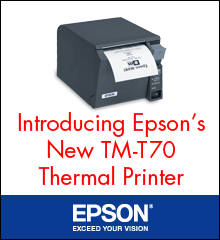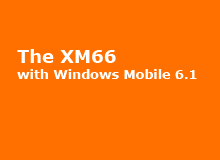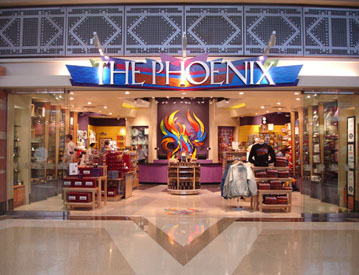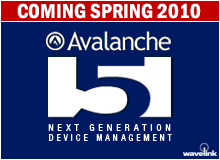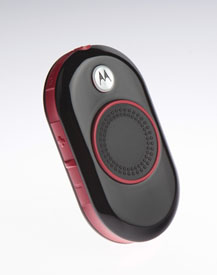
Michael Kachmar, Editor
(If your e-mail client does not display this properly, click here.)
This Week’s Product Pick
Data Ltd. Inc. (LaPorte, IN) used last week’s National Retail Federation Show in New York to debut its DLI 8800 Mobile POS Tablet. This small-format, ruggedized tablet computer features an integrated three-in-one payment module--MSR, Adaptus scanner/imager from Honeywell, and RFID reader--allowing retailers to handle customer transactions throughout the entire store, hotel, or stadium environment. Weighing just 2 lbs., and OPOS/JPOS-compliant, the DLI 8800 employs high-contrast, outdoor readable 7-inch LED backlight display (with resistive touchscreen available). The device is powered by Intel’s Atom 1.6-GHz processor and handles Wi-Fi 802.11a/b/g/n, cellular, and Bluetooth communications. All major O/S are supported, such as Microsoft Vista Business, Windows 7, XP Pro, XP Tablet, Windows Embedded Standard, and Linux 2.6 (Ubuntu). Finally, the DLI 8800 comes housed in an IP-54, impact-resistant ABS+PC polymer shell rated at multiple four-foot drops to concrete. DLI puts MSRP at $1,665 and also offers its No-Fault Service plan. “At DLI we design, manufacture, and service the industry’s most innovative and affordable rugged mobile computers,” declared Bryan Wesolek, DLI Founder and President. “Our tablets and in-vehicle devices form the foundation of high-value mobile computing solutions throughout the entire enterprise and diverse industries.”

DLI 8800 Mobile POS Tablet
COMPANY BUSINESS Microsoft Takes AX to Retail What now for Microsoft in POS? Likely path has been revealed by the preview of Microsoft Dynamics AX for Retail at last week’s National Retail Federation Show in New York. The new solution seeks to satisfy retailers’ end-to-end needs--POS, store management, supply chain, merchandising, and financials--in one neat package. It combines the recently acquired technologies of LS Retail EHF and To-Increase Denmark A/S with the enterprise resource planning (ERP) capabilities of Microsoft Dynamics AX. Further, it drives efficiencies across additional Microsoft products such as Windows 7, Microsoft Office, Microsoft SharePoint Server, and Microsoft SQL Server. Expect general release in summer of 2010. “A big advantage of Microsoft Dynamics for Retail AX is that we’re getting the pieces we need right out of the box, and those pieces work seamlessly with other Microsoft products in an interface that’s familiar to our users,” testified Vadim Motlik, CFO of HDS Retail. “This eliminates the need for back-end customizations, eliminates duplication of data and effort, and reduces training times.” HDS is the wholly owned subsidiary of Lagardere Services, the world’s largest travel retailer. It runs 350 stores in North America. Microsoft Dynamics AX for Retail supports Payment Service for electronic transactions as well as other online schemes specifically geared toward the retail market, including Commerce Service, which will debut in the first half of 2010. Commerce Service links Microsoft Dynamics ERP products with business-to-consumer e-commerce marketplaces, dedicated e-commerce storefronts, and built-in shopping cart functionality. Dynamics AX, RRN.Com readers will recall, is one of four offerings in the Microsoft Dynamics ERP product line. It targets five key industries: retail, manufacturing, professional services, distribution, and the public sector.
Prix Fixe Payment Processing The goal of simplified, unified payment processing for foodservice will be addressed by the new partnership between the National Restaurant Association (Washington, DC) and Heartland Payment Systems (Princeton, NJ). “Full Course Business Solutions” will launch with an exclusive, NRF-endorsed suite of Heartland products--including card processing, payroll, check management, and tip reporting and compliance services. This package will be supported by Heartland’s national sales and servicing organization of 1,800 professionals located in communities across the U.S. as well as its 1,600 employees in IT, support, and administration. Heartland will offer more competitive pricing for restaurant owners who choose to participate, based on the scale of this partnership. “We are pleased to announce our partnership with industry leader Heartland Payment Systems and offer this valuable suite of products to our membership,” stated David Gilbert, COO, National Restaurant Association and Executive Director of National Restaurant Association Solutions. “Saving time and money is critical to every operator, and Heartland’s products will boost our members’ profitability. In addition to best-in-class products, Heartland’s nationwide staff will provide unparalleled service and support.” “The goal of this alliance is to upgrade and control the costs of the crucial business services needed by every restaurateur,” detailed Bob Carr, Heartland’s Chairman/CEO. “Heartland’s national sales and servicing organization of restaurant specialists--combined with our proprietary processing platforms for payments and payroll--enables us to provide ever-evolving solutions for our business partners. This strategic partnership, together with our long history of organic growth, provides clear evidence of the value of Heartland’s ‘fair dealing’ business model and of its Merchant Bill of Rights [introduced in 2006 for public advocacy in the area of payment processing].”
|
|
Worth Your While
Connect
Radiant Retail User Conference
February 24-26
Atlanta
Self-Service Expo & Digital Signage Show
KioskCom
April 14-15
Las Vegas
NACStech
Association for Convenience and Petroleum Retailing
May 5-7
New Orleans
FMI Show
Food Marketing Institute
May 10-13
Las Vegas
[Editor’s Note: The FMI Show for 2010 will include technology sessions and exhibits, since Marketechnics has not been scheduled for this year.]
WERC Annual Conference
Warehousing Education and Research Council
May 16-19
Anaheim, CA
NRA Show
National Restaurant Association
May 22-25
Chicago
POS Partner Invitational
Ingram Micro Data Capture/POS Division
May 26-28
Chicago
ALL IN THE FAMILY
LXE Drives Trux
LXE (Atlanta) has extended its Trux product line of rugged vehicle-mount computers with two recent newcomers to these shores. The VX8 Karv and VX9 Forj terminals bring enhancements such as sharper LED backlight displays, Intel Atom and Core 2 Duo processing speeds, and mobile radio connectivity. Both devices take their lineage from LXE’s Trux Group in Sweden, with Karv named for the small, maneuverable Viking ship used for both battle and merchant missions, and Forj alluding to the strong, precise materials which emerge from the blacksmith’s forge, as the company explained.
Karv sports Atom 1.6-GHz or Core 2 Duo 1.5-GHz processing and up to 2 GB of RAM. Features include 10.4-inch touchscreen LED display and communications capabilities for 802.11a/b/g, Bluetooth, and Wireless Wide Area Network (WWAN). The unit’s compact magnesium enclosure, rated to IP-65, was engineered to handle extreme environmental conditions. The Forj computer represents the larger counterpart, with 12.1-inch touchscreen.
According to Bill Roeder, LXE’s VP of Business Development and Marketing, “The Karv and Forj computers are suited for a wide range of applications--intermodal, airports, outdoor logistics like forestry, as well as the warehouses and distribution centers for which LXE is know--but their true value comes from network management benefits. Knowing that these devices are fully Windows desktop-compatible helps IT management, and the energy-efficient LED displays and Atom processors contribute to high performance at the lowest lifetime cost of ownership.”

VX9, or Forj, Vehicle-Mount Computer from LXE
Printing Fancy with Primera
Primera Technology (Plymouth, MN) unwrapped its new LX900 color label printer with speeds of up to 4.5 inches per second--more than 15 times faster than the company’s best-selling LX810. Served up at last week’s Winter Fancy Food Show in San Francisco, the LX900 addresses specialty sales, private labeling, test marketing, and pre-press proofing. Separate ink cartridges for cyan, magenta, yellow, and black keep operating costs low, since only one color needs to be replaced at one time. In addition, an all-new, semi-permanent print head delivers photo-realistic text and graphics, according to the company.
Printer drivers are included for Windows XP/Vista/7 and Mac OS X 10.5 (or higher), along with easy-to-use label design software for Windows. Substrates include many different inkjet-qualified label and tag materials, including polyester, polypropylene, and water-resistant paper. Label sizes range from 0.75 inches wide and 0.75 inches long up to the maximum of 8 inches wide and 24 inches long. The LX900 carries an MSRP of $2,995 and will go to market direct and through Primera’s resellers and distributors worldwide.
“LX900 establishes the new industry standard for print speed, print quality, and low operating costs,” declared Mark Strobel, Primera’s VP of Sales and Marketing. “We listened carefully to our users. They told us that faster printing and separate ink tanks were the most important new features we could offer. At the same time, they weren’t willing to sacrifice the excellent print quality they were getting from their existing Primera color label printers. LX900 delivers on all this and more.”
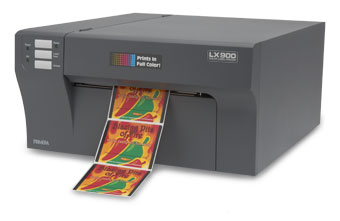
Primera’s LX900 Color Label Printer
Join the Party at No Charge
Do you need to reach the POS & Auto ID resellers who really drive business—in the most targeted editorial environment, and on the most cost-effective basis?
E-mail Michael
Kachmar for advertising information,
or call 973-270-3284
Did you miss one of our issues and suddenly realize your competitors know more than you do?
Hurry ! Use the links below to catch up :
ENVIRONMENTS/PLATFORMS
Mercury to Shield POS Developers
Mercury Payment Systems (Durango, CO) has unsheathed MercuryShield, its new PA-DSS validated payment scheme designed to simplify things for POS developers. Upon swipe or manual entry, MercuryShield transmits transaction data directly into the Mercury Payment Systems secure network, passing back all necessary, non-sensitive cardholder information to the POS. Thus, the cost and effort of achieving PA-DSS compliance in the POS solution can be avoided, according to the company. Mercury said it will offer MercuryShield at no cost to its qualified developer partners.
“Achieving PA-DSS validation can be a very expensive and cumbersome process,” reported Lucas Zaichkowsky, Senior Compliance Technologist for Mercury Payment Systems. “We developed MercuryShield to remove the obstacles of PA-DSS validation for POS developers. This frees them to focus on their core business.”
Zaichkowsky described MercuryShield as “easy to integrate.” Prospective developers can get the MercuryPay processing platform and MercuryShield application in one integration package. Featuring backwards compatibility with existing MercuryPay integrations, MercuryShield supports credit, PIN debit, and MercuryGift card processing.

Lucas Zaichkowsky, Senior Compliance Technologist, Mercury Payment Systems
Accellos Aided by Acquisition
More news concerning Microsoft Dynamics AX: Accellos, Inc. (Colorado Springs, CO), one of the leading providers of logistics, warehousing, 3PL, and transportation solutions, has purchased vSync, Inc. (Columbus, OH). vSync purports to be the only supplier of EDI and shipping compliance software specifically developed to enhance Microsoft Dynamics GP and Microsoft Dynamics AX. Accellos will continue to market and support the vSync product line, which will be merged into Accellos One, its supply chain execution suite for SMB end-users built upon Microsoft .NET and Silverlight technologies.
“We see entire new areas of growth and capability with vSync,” related Joel Kremke, COO at Accellos. “As channel-leading technologies, vSync EDI and shipping solutions add more than just transaction processing. They extend our supply chain functionality by enabling suppliers to track, manage, and process customer-specific data requirements and processes. This is truly winning for our combined customer base as well as our shared reseller channel.”
With the addition of vSync, Accellos now has 195 dedicated employees and nearly 4,000 supply chain customers. Both Accellos and vSync are Microsoft Gold Certified Partners in the area of Microsoft Dynamics. Financial terms of the acquisition were not disclosed.
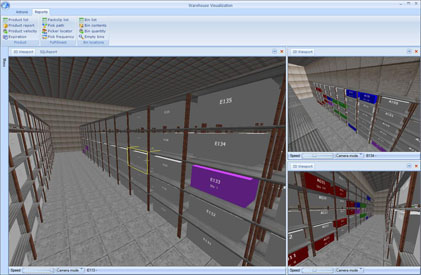
Virtual Warehouse Tour from Accellos
Code
Corner
Retail Pro (Folsom, CA) launched its internal project, dubbed “Aruba,” which will bring the company’s next-generation software to market. The first release, scheduled to be completed later this year, will address thin-client architecture compatible with existing versions of Retail Pro. In its final configuration, Aruba will be offered to customers on-premise or in the cloud via SaaS delivery, targeting the need for reduced hardware and IT infrastructures. As project goals for Aruba, Retail Pro cited greater flexibility, enhanced ease of use, reduced acquisition and maintenance costs, faster deployment, and real-time data processing. “We are extremely excited about project Aruba on a number of different levels,” stated Kerry Lemos, CEO at Retail Pro. “Aruba marks our collaborative effort with our Customer and Partner Advisory Groups. Their input indicated our customers were looking for a solution that can immediately meet their unique business needs and processes while lowering total cost of ownership. Through thin-client architecture that runs on our centralized, organizational structure, Aruba delivers on those needs.”
TAKE Supply Chain (Austin, TX), formerly known as ClearOrbit, tendered OneSCM, its new multi-tenant SaaS platform designed to bring online supplier management to medium and large enterprises. The solution enables manufacturers and distributors to create supplier response transactions that function against purchase order schedules. As part of the solution, it provides shipment execution tools such as part tracking numbers (PTNs), label printing, and status updates. A unified set of individual applications--Procure-to-Pay, Order-to-Cash, Accounts Receivable Automation, and Accounts Payable Automation--have been positioned separately or as fully-integrated modules, according to the developer. Additionally, OneSCM was configured to deliver value quickly through pre-built integration with SAP and Oracle, industry-standard interfaces such as PIDX and RosettaNet, and through its fully stable and secure environment that meets SAS 70 Type 1 and Type 2 standards for SaaS applications. “OneSCM is our platform and set of integrated applications that industry-specific ecosystems will use to perform supply chain activities across all their value-adding partners,” commented Warren Sumner, COO and GM at TAKE Supply Chain. “This means that brand owners, goods and services providers, distributors, and customers will each realize unique value from OneSCM.”
INTEGRATION
Elo Spawns D-Series
Elo TouchSystems (Menlo Park, CA) introduced its D-Series All-in-One touch computer family, spawned by the success of the company’s popular 15D1. Targeted at the SMB market for retail and hospitality, the D-Series includes four new choices of versatile, highly functional, and stylish touch computers, according to the company. Features include compact footprint sized to match standard cash drawers, the full range of POS input/output ports and peripherals, and easily accessible motherboard, hard drive, and power supply for replacement in the field.
“The original 15D1 represented an evolution in touch computer solutions,” suggested Steve Aguirre, Product Manager at Elo. “It delivered what our customers wanted--a small-footprint touch computer that combined performance, strong value, enhanced field serviceability, and more connectivity options. Now they have four more choices based around an Intel Celeron Dual Core 2.2-GHz or Core 2 Duo 3-GHz and 15-inch or 17-inch touchscreens.”
Not surprisingly, D-Series touch computers offer three Elo touch technologies: zero-bezel AccuTouch resistive, standard-bezel IntelliTouch SAW (surface acoustic wave), or zero-bezel APR (acoustic pulse recognition). Each unit comes with the Windows Embedded for Point of Service (WEPOS) operating system fully installed, enabling broad compatibility with peripheral software and drivers (with Windows XP and OPOS for the 15D1). For customers who require more storage capabilities, another 160-GB hard drive may be added. “We’re confident this family will exceed the expectations of even our most exacting customers,” Aguirre concluded.
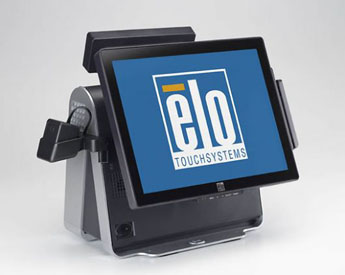
Elo TouchSystems’ 15D1 All-in-One
Just Got Cone Free at Tasti D-Lite HQ . . .
Customer loyalty has been directly linked to social networking in an installation for Tasti D-Lite by pcAmerica (Pearl River, NY). Customers who enroll in the Tasti D-Lite program can sign-in online and connect their Twitter and Foursquare accounts to their myTasti.com account. Every time the customer uses their “TreatCard” when making their purchase, an automatic Tweet and Foursquare check-in gets posted by pcAmerica’s Restaurant Pro Express POS system, indicating that they have earned reward points. For every 50 points earned, one medium cup or cone may be redeemed, another activity that is posted by pcAmerica’s POS terminals to Twitter and Foursquare.
“Tasti D-Lite is continually looking for new and innovative ways to interact with our customers,” noted B.J. Emerson, Director of Information and Social Technologies for the frozen dessert chain. “Many of our customers already share their experiences at Tasti D-Lite on Twitter and Foursquare. Creating this platform to reward them for using and promoting the brand through social networking was the natural evolution of our marketing strategy.”
“Social networking is an affordable marketing method that can be utilized by both chains and smaller, independent businesses,” shared David Gosman, CEO of pcAmerica. “Showing a tweet when a customer gets a free dessert can have a viral effect as other potential customers wonder how they also can get a free dessert. In short, with the adoption of this new POS technology, social networking now equals affordable viral marketing.”

POS from pcAmerica Bridges Social Networking and Customer Loyalty
Key
Advertiser
Links
Be sure to visit these vendors for the latest in channel products and offers for resellers.
POS & Auto ID Distribution
BlueStar
ScanSource
POS & Peripherals
FEC USA
Logic Controls
Pioneer POS
Posiflex Business Machines
POS-X
Barcode & Mobile Printers
Datamax-O'Neil
Cash Drawers
APG Cash Drawer
MMF Cash Drawer
Data Collection Terminals
CipherLab
Datalogic
Mobile
Honeywell Scanning & Mobility
Janam Technologies
Data Collection Software
Wavelink
Integrated Payment Solutions
Datacap Systems
Receipt
Printers
Bixolon America
Citizen Systems America
Epson America
Star Micronics
Screen Protection
3M Optical Filters
Self-Service Kiosks
Zebra/Motorola
PARTNER PROGRAMS
Wireless by the Square Foot
Motorola Enterprise Mobility Solutions (Holtsville, NY) opened its Wireless LAN Cost Calculation Service, which enables customers and resellers to estimate the cost of an investment in WLAN infrastructure and wireless services on the handy per-square-foot basis. Offered at no charge, the online configurator can help margin-sensitive retailers assess the hidden costs of wireless operations and improve network planning, budgeting, and operations, according to the vendor. It provides an analysis of the total cost of ownership by square foot and makes comparisons between potential solutions. For resellers, it also opens the door to providing managed services, RRN.Com was told.
“The value of a mobility solution to a retailer is based on its ability to facilitate better operations and services while decreasing expenses, yet retailers often struggle to predict just how much their wireless network decision will cost them and how it will affect their profitability,” observed Sujai Hajela, VP for Wireless Network Solutions, Motorola Enterprise Mobility Solutions. “Motorola’s new service helps customers and channel partners create ‘what if’ scenarios that demonstrate just how affordable Wireless LANs can be and ensure the best investment decision for their operation.”
Busy NRF Show for Motorola last week. In addition to the Wireless LAN Cost Calculation Service, the company demonstrated its Mobile Loyalty Solution, which will allow retailers to proactively send offers and incentives to the customer’s mobile phone--eliminating the need for membership cards and paper coupons. An assigned barcode acts as the shopper’s unique identifier, or mobile loyalty card, and can be scanned at the POS. Finally, Motorola added new two-way radios, the CLP and the Team Badge EWB100. Both are lightweight, easy to use, and suitable for retail, restaurant, and hotel environments.
CLP Two-Way Radio from Motorola, in Nifty Red
Vukunet, God of Recurring Revenue
NEC Display Solutions of America (Chicago) has promised channel partners recurring revenue from advertising if their customers register their digital signage networks on its Vukunet platform. Vukunet gives advertisers and agencies an easier way to buy place-based, digital out-of-home (DOOH) advertising, according to the vendor. It provides free content management software (CMS), with ad placement, proof of performance, and payment all centrally managed and automated on the web.
“Vukunet is going to help our end-user customers see return on their digital signage investments via advertising revenue, but we wanted to offer our VARs an opportunity to enjoy the benefits of entering this new market with explosive growth,” commented Ashley Flaska, VP of Marketing for NEC Display Solutions. “Everyone is looking for recurring revenue streams, and our Vukunet platform is the first to get the channel involved in the advertising space with little or no overhead. Advertising revenue for these DOOH networks is approximately ten times the size of the hardware, software, and installation of such systems, according to various analysts.”
Under Vukunet, digital signage networks can be comprised of any vendor’s products, not just NEC’s, and existing CMS systems can remain in use. This compatibility allows network owners and operators who have already invested in hardware and software to use the NEC Display platform without any additional expense. In order to participate in the program, VARs need to be part of NEC’s Partner Net site, participate in Vukunet training, and sign the accompanying paperwork.
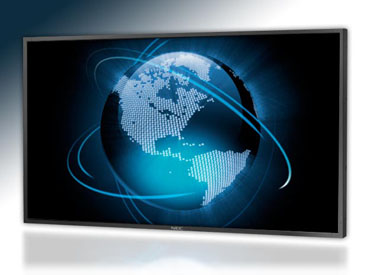
NEC Sets Channel Path to Digital Signage Advertising
[Editor’s Note: Elsewhere, NCR Netkey kicked off its Digital Signage SmartStart program, charged with helping companies get started in this area. The program runs through March 31 and includes on-site business consulting and joint creation of low-cost pilot programs.]
Channel Factoid
SMBs have become more sophisticated in their technology purchases, welcoming SaaS and managed service providers (MSPs), according to new research from CompTIA. Its survey of more than 400 SMBs across the U.S. finds that nearly 30% plan to implement SaaS solutions in 2010. That’s up from 22% and 14%, respectively, in the two prior years. Almost one-third (30%) intend to implement managed service solutions this year, according to CompTIA. Since 42% of SMBs lack formal IT departments, relying instead on workers handling IT needs in their spare time, the managed service model neatly fills this skills gap. “Between 70% and 80% of the SMBs we surveyed consider the use of ERP, CRM, and online e-commerce capabilities as strategic to their business,” said Tim Herbert, VP, Research, CompTIA. “IT solutions that are tied to instant return on investment in business communication and customer outreach efforts have the highest likelihood of adoption.” What are these SMB expecting from their technology providers? 86% demand partners who truly understand their business needs. 83% want partners who are able to provide scalable solutions.
GEAR BOX
Wearing the Green at Epson
Epson America (Long Beach, CA) has touted the energy efficiency of its two of its leading POS printers, the TM-T88IV and the TM-H6000III, by citing side-by-side test results among competitive products performed by Seiko Epson Corporation in 2009. “When purchasing peripherals, retailers are looking for top quality and reliability, as well as green products that can potentially lower operating costs throughout the store,” remarked Mike Helm, Director of Sales and Marketing, Epson System Device Group. “Epson has a strong legacy of environmentally-conscious design and manufacturing, and we will continue to bring the most energy efficient products to the market.”
Epson’s TM-T88IV single-station thermal printer with USB interface was tested against nine competitive models, according to the company. Results indicated that the Epson TM-T88IV uses between 53% and 84% fewer kilowatt hours as compared to the next best performing and worst performing models tested. Results also showed that the Epson TM-T88IV, introduced in 2005, uses significantly less energy than some of the same-class printers introduced in 2009. With over five million units installed worldwide, Epson’s TM-T88 Series is the best-selling thermal printer in the POS industry.
In addition, Epson’s TM-H6000III multifunction printer with USB interface was tested against three competitive models, the company continued. Results indicated that the Epson TM-H6000III uses between 39% and 48% fewer kilowatt hours as compared to the next best performing and worst performing models tested. Results also showed that the Epson TM-H6000III, introduced in 2006, uses significantly less energy than newer same-class printers. The TM-H6000III delivers high-speed receipt and slip printing, endorsement, two-color graphics, and MICR accuracy of over 99.9%.
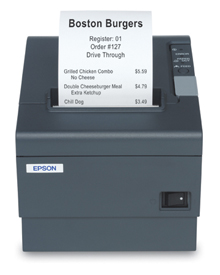
Epson’s Recently Re-Engineered TM-T88I ReStick Printer
Here Comes the Judge for 2D
Responding to increased implementation of GS1 DataMatrix and other two-dimensional barcodes, GS1 US (Lawrenceville, NJ) has dealt its new tool for calibration and verification of such systems. The GS1 DataMatrix Calibrated Conformance Standard Test Card (CCSTC, for short) references symbols of exact dimensional and reflectance values and can be used to determine if the user's barcode verifier is accurate and performing within published tolerances. The new card, which costs $600, complements an existing product line of GS1 US test cards for linear symbologies such as UPC-A, EAN-13, ITF-14, GS1-128, and GS1 DataBar.
In order to produce the DataMatrix CCSTC, GS1 US collaborated with AIM, the Association for Automatic Identification and Mobility. The multi-year project included the development of the high-resolution “2D Judge,” which precisely measures, analyzes, and validates the symbols on the test card. The 2D Judge was built under the direction of Kevin Berisso, Director of the Auto ID Lab at Ohio University, part of the Russ College of Engineering and Technology. Global mail-stream technology leader Pitney Bowes created the 2D Judge’s image-analysis software and symbology decoding algorithm.
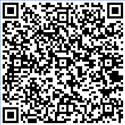
Calibrating and Verifying DataMatrix Accuracy
PinPoint Media
All Rights Reserved


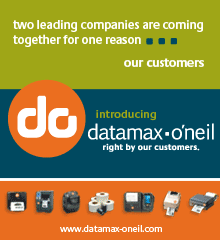
 600x120_G8.gif)
